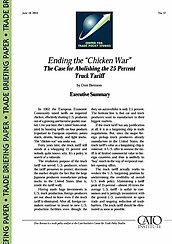Forty years later, the truck tariff still stands at a whopping 25 percent. While the other retaliatory measures were lifted over the decades, the truck tariff remains, and nobody quite knows why. It’s a policy in search of a rationale.
The retaliatory purpose of the truck tariff was served. Volkswagen, the intended target, no longer even produces the vehicles subject to the tariff. U.S. producers, whom the tariff presumes to protect, dominate the market regardless of the tariff. Despite the fact that a the large Japanese nameplate producers manufacture pickup trucks in the United States — a fact related to the existence of the tariff in the first place — the Big Three hold 87 percent of the U.S. pickup truck market.
The concern that imports would run roughshod over domestic producers in the absence of the tariff is hollow. All of the world’s major producers are already operating in the United States. Having made huge investments in U.S. truck production, they’re not about to leave even if the truck tariff were eliminated. After all, foreign carmakers continue to invest in new U.S. production facilities even though the duty on automobiles is only 2.5 percent. The bottom line for cars and trucks is that producers want to manufacture in their biggest markets.
If the truck tariff has any justification at all, it is a bargaining chip in trade negotiations. But since the major foreign pickup truck producers already manufacture in the United States, the truck tariff’s value as a bargaining chip is minimal. A U.S. offer to remove the tariff is of limited commercial value to foreign countries, and thus is unlikely to “buy” too much in the way of reciprocal market‐opening offers.
Meanwhile, the truck tariff actually works to weaken the U.S. bargaining position by undermining the credibility of overall U.S. trade policy. Maintaining a tariff peak of 25 percent — almost 10 times the average U.S. tariff — is unfair to consumers and is jarringly inconsistent with the general U.S. commitment to open trade and ongoing liberalization of trade barriers. The truck tariff should be eliminated as soon as possible.
